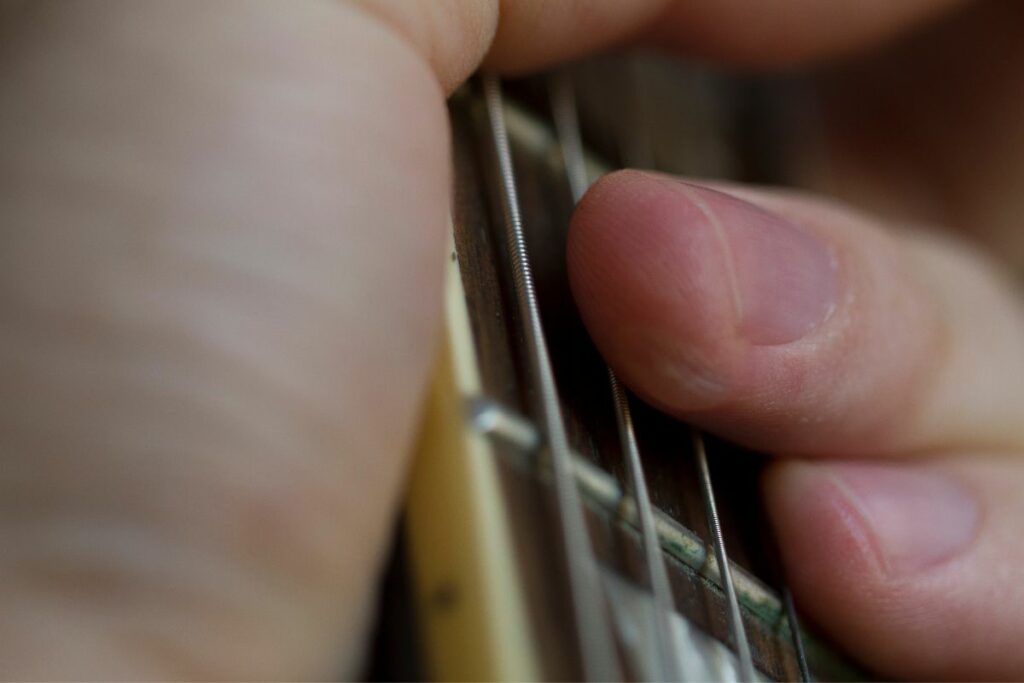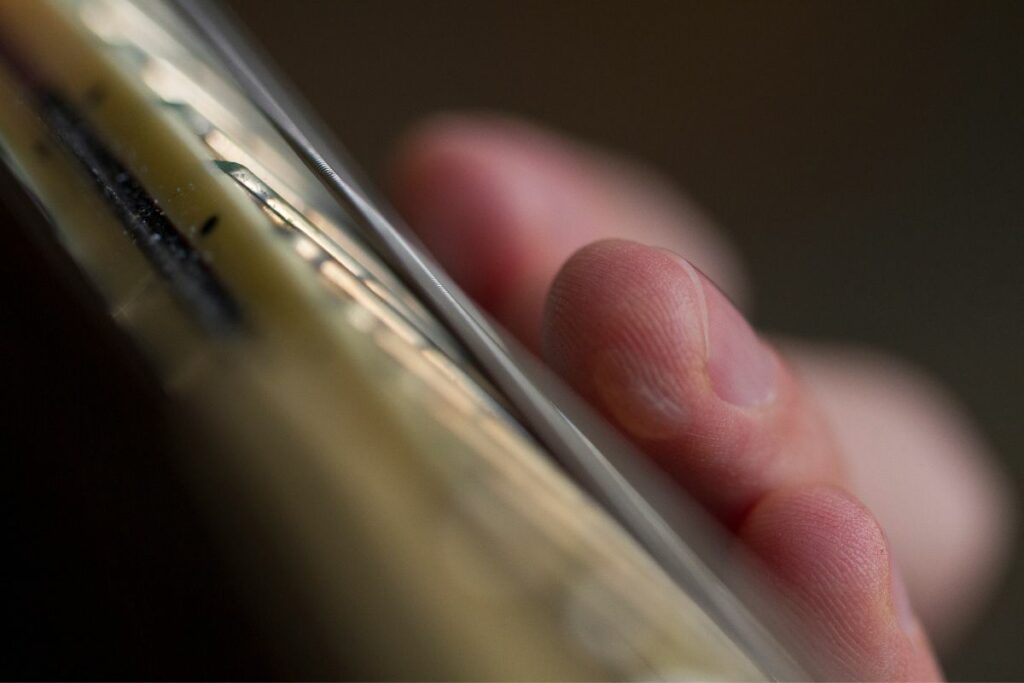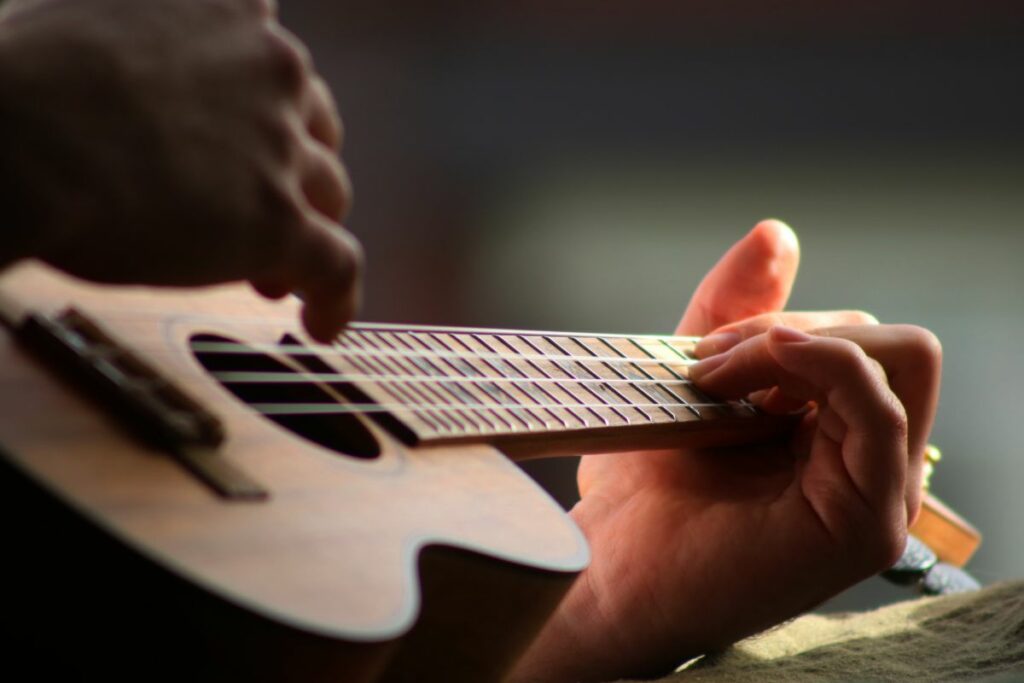BecomeSingers is reader-supported. When you buy through links on our site, we may earn an affiliate commission. Learn More
Getting blisters on your fingers from playing guitar is pretty much a rite of passage for any beginner. We’ve all been through it. It’s painful initially, but it quickly gets better and becomes a lot less frequent once you’ve formed some calluses. So, don’t worry.

Over 8 years of playing guitar, I have seen a lot of blisters, big and small. I put together the best ways to get rid of your blisters, so you can get back to playing guitar faster. Plus, I’ve added pro tips for preventing them from happening again and keeping your fingers healthy.
Table of Contents
Why Do Blisters Form on Your Fingers When Playing Guitar?
Blisters form on your fingers when playing guitar because of the friction and pressure the strings exert on your fingertips. The repeated rubbing and pressing of the strings against your skin can cause tiny tears in the upper layer of your skin, creating a fluid-filled blister.
Essentially this is a lot like the blisters you get when you touch a hot pot, as the friction against metal strings also creates heat. This is completely natural because our skin isn’t meant to be pressing down on thin metal strips for hours on end!

Factors leading to blister formation include playing with high-tension strings (beyond 12 gauge) or using a guitar with high action (the distance between the strings and fretboard). Playing for extended periods of 3-4 hours without any breaks (or even too few) can also increase this.
How to Get Rid of Blisters on Your Fingers
Whether you’ve got a blister from plucking, strumming, fingerpicking, tapping, or even on your thumb, they’re mostly the same. Here are some tips for getting rid of guitar blisters faster:
1. Take a break and allow it to heal
While blisters are painful and frustrating, they will take time and patience to heal. If you’re feeling lazy anyway, just take a few days off, and everything will heal. Your skin will start to form calluses on its own, making it easier the next time you play.
If you try to play guitar with blisters, it’s really going to hurt even more, and you risk popping and infecting the blister. So just wait it out and let your skin heal itself. Sometimes it can take up to a week or even longer, but the following tips can help ease the pain and speed up the healing.
2. Keep the blisters clean and disinfected
Blisters themselves are just filled with serum from your blood and aren’t infected or contagious. But the broken skin makes it risky and susceptible to infection. So it’s super important to regularly clean and disinfect the area around the sore fingers.
Wash your hands frequently, and use some antiseptic like isopropyl alcohol. Don’t apply too much, as it might irritate the skin, but just enough to keep it disinfected. Since using a disinfectant or even soap can dry out your skin more, the next tip is essential.
3. Apply an ointment, balm, or moisturizer (such as Vaseline or any petroleum jelly)
You can apply an ointment or balm on and around your blister to help the healing process. Petroleum jelly is generally quite safe and easy to use, so you can try that. Just apply a thin layer over the skin, and let it dry out naturally.
Chapped, dry skin is more likely to blister and crack than soft, moist skin, so it’s best to keep your fingers hydrated. Applying something like Vaseline or a healing salve can help protect the skin, while also replenishing moisture. You can even try Aloe Vera extract or gel.
You can also apply a small bandage or gauze over the area to prevent it from receiving more friction or getting worse.
4. Apply a cold compress
A cold compress helps soothe the area and numbs the pain, making it very useful if your blister is still hurting even after a few days.
For this, you can use an ice pack wrapped in a clean, dry handkerchief or thin towel, and apply it sparingly for 10-15 minutes. If the compress starts to feel uncomfortable, remove it for a few minutes before trying again.
Just make sure whatever you use is clean and preferably covered with a thin cloth to reduce the coldness and keep your fingers comfortable.
5. Consult a doctor if it hurts too much or seems infected
If after 4-5 days (or perhaps a week), you find your blister isn’t healing much, or if it seems infected (it’s red/black and gets worse over time), it’s best to consult a doctor.
Doctors can help treat any infections that may have arisen, plus they can give you medicines like painkillers to help with the pain and redness. If going to a doctor seems unfeasible, at least try to go for a teleconsultation to avoid any risk.
A doctor can also help drain the blister if necessary. They typically use a sterilized needle to puncture it and allow the fluid to drain out. But you shouldn’t try this yourself to avoid risking an infection or hurting yourself even more.
Methods to Prevent Blister Formation on Fingers When Playing Guitar

Know that blisters are a common occurrence for guitarists, but once your fingers form calluses and you get used to it, they’ll stop coming again. So here are some tips to prevent blisters, develop calluses quicker, and keep your fingers in top condition for guitar playing.
1. Take regular breaks while practicing
It’s important to take regular breaks when practicing guitar. For example, practice for an hour and rest for 30-45 mins before picking it up again.
Don’t be too tempted by stories of famous guitarists practicing for 12 hours a day: such rigorous regimens aren’t really good for your fingers or your overall physical health. Muscle memory and calluses develop over repeated practice sessions over long periods of time.
The exact limits for guitar playing are quite individual, but that’s where the next tip comes in. It can take some time to figure out a practice routine that works well for your music goals and keeps you healthy: just remember to space it out and take breaks.
2. Stop playing if it starts to hurt
This is the golden rule: if it starts to hurt while you’re playing guitar, it’s time to take a break. Never push yourself beyond your limits, because it’s really going to hurt eventually.
An explainer: when your fingers start to hurt, the skin is already getting peeled away. If you play for longer, it’s going to peel away enough to expose your fragile nerve endings, which can cause permanent damage to your fingers if you’re not careful.
If it gets to the point where even touching a guitar string sends a sharp pain through your hands, that means the nerves are getting exposed, and you probably need to rest for at least a week to allow them to fully heal. Nerve cells heal much slower than skin does.
3. Practice proper techniques with good finger positioning and pressure
Often, sore fingers and guitar blisters happen because of improper technique: beginners use too much pressure while trying to play guitar, and the strings quite literally dig scars into their skin. Also, make sure you’ve got short nails.
To avoid this, you need to make sure you’re applying just the right amount of pressure to fret the note, without any buzzing. The minimum force that creates a ringing note. If you apply less, it’ll probably buzz. And if you apply more, you’ll end up hurting yourself.
Practice like this for every string, all across the fretboard. With time, your fingers will naturally adapt and remember how much pressure to apply the next time you play, as it all becomes a part of muscle memory.
4. Use light gauge strings and lower your guitar’s action
If you’re using heavier gauge strings like 11s, 12s, or even more, try a lower one. I recommend starting at 10, and sometimes even using 9s if you want a comfortable experience.
A thinner gauge has much lower string tension, meaning you need less finger pressure to fret the note. So it’ll help you get better technique + save your fingers from getting blisters.
Also, lowering your guitar’s action can help too. Several acoustic guitars come with very high action on the higher frets (12th fret and beyond). So if you’re trying to play scales and lead guitar, it gets really difficult.
While it’s absolutely possible to lower your guitar action by yourself, you can consider taking it to a luthier or guitar tech to help you achieve the best results.
5. Hydrate yourself and moisturize your fingers
Last, but also the most underrated: hydrate yourself regularly. As musicians, I know that many of us just don’t end up drinking enough water and other fluids. But it’s essential, so your skin stays healthy and moisturized (and also to keep you focused for practicing properly).
Depending on your skin type and climate, you may need to moisturize your fingers too. Applying petroleum jelly or another cream can help. But don’t overdo it either, because you don’t want to soften the calluses. You just need enough to stay hydrated and moisturized, for better self-care.
Check our article on How to Restring a Guitar.
FAQs
Should I pop a guitar blister?
Will guitar blisters turn into calluses?
How do I protect my fingers when playing guitar?
Conclusion
Blisters are common for guitar players, particularly beginners or those returning to playing after a break. I hope that the tips I’ve mentioned help you get rid of them quickly, and also prevent them from happening again in the future. With proper care and practice, you can enjoy playing guitar without discomfort or pain.
If you found this guide helped you out, feel free to share it with your friends, and don’t be shy to send in any suggestions or queries!





